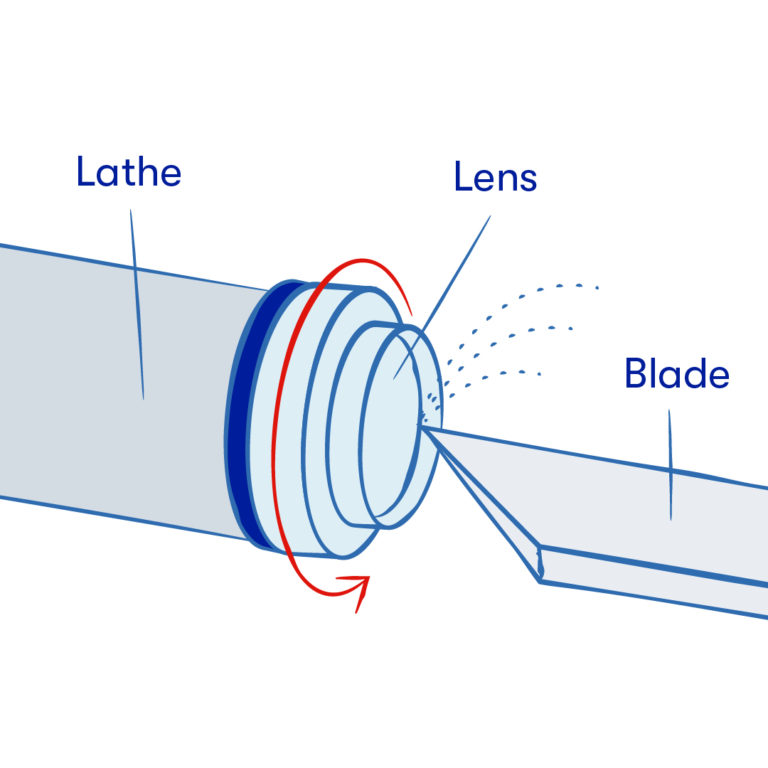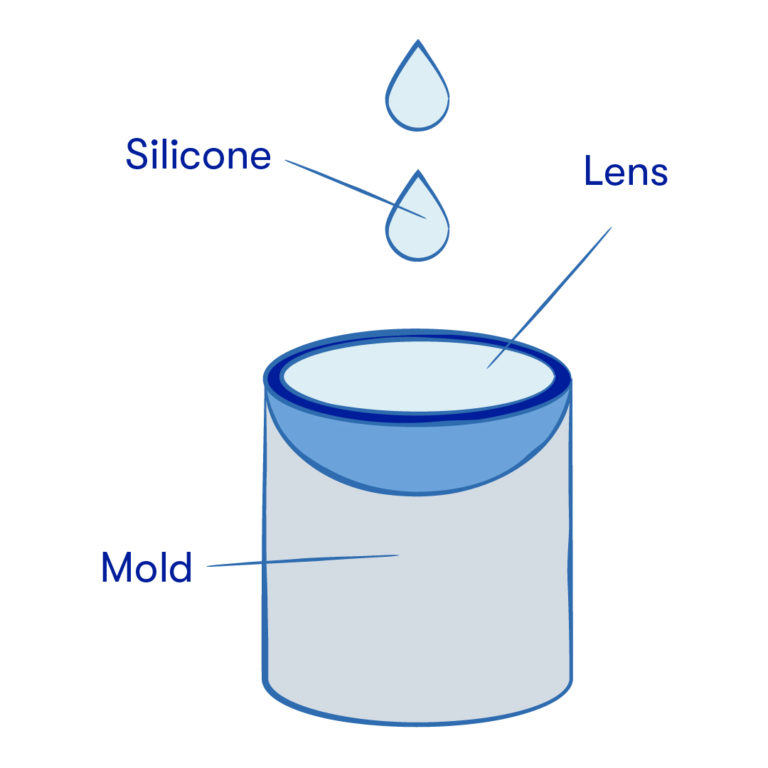How are my contacts made?
You wake up every morning and put a thin, clear material directly over your eye — and voila, the world becomes crystal clear. You no longer have to walk around scrunching your face to see the world around you. It almost feels like magic.
If you’re here to demystify some of the magic behind contacts, you’ve come to the right place. We provide answers to questions about how contacts are made and what they're made of.
Making contact lenses
Contact lenses can be manufactured in various ways, including lathe cutting, spin casting, and injection molding. The exact details of how your contacts are made depend on the type of contacts you wear. Soft lenses are often mass-produced for a general fit, while hard contacts are made to fit the specific individual.
As a result, if you wear hard contacts, your left and right eye contacts may differ even if they're produced the same way. Most people don’t have the exact same prescriptions or measurements for each eye. Turns out, we've all got a bit of Picasso in us, after all.
Today, contacts are made of plastic polymers, but this wasn’t always the case. Contacts used to be made of glass. You heard that right; people put rigid, hard, and breakable glass in their eyes. Let's all take a moment to thank science for its advances. Contacts are a much safer and more comfortable experience today.
The general process of manufacturing contact lenses today is as follows:
-
The contact is designed based on prescription specifications.
-
The lens is created from the chosen material.
-
The lens is molded to the prescription specifications.
-
The lens is cut into its shape using a method such as lathe cutting.
-
The lens is polished and hydrated.
-
The lens is inspected for imperfections and packaged.
Method #1: Lathe cutting
Lathe cutting involves small, hard, non-hydrated disks of contact lens material that are placed onto a spinning shaft, and a computer-controlled cutting tool cuts and shapes them. The spinning shaft rotates at 6,000 revolutions per minute. Lathe cutting is used to produce individually specified lenses.
The exact manufacturing process for lathe cutting is as follows:
-
The lens is mounted in preparation for cutting.
-
The lens rotates at an incredibly high speed.
-
The computerized tool precisely cuts the disk into the shape of the contact.
-
The lens is polished and hydrated for a comfortable fit.
-
The lens is inspected and tested for quality control.
Contact lens brand Ultra uses lathe cutting in its lens production. Additionally, popular manufacturer CooperVision (responsible for brands such as Biofinity) uses lathe cutting in some of its lens production.
Method #2: Spin casting
Spin casting is the process of injecting a liquid polymer into a spinning mold to form a soft contact lens shape. Unlike lathe cutting, which is used to make personalized shapes, spin casting is common for mass production. It can work faster and produce at a higher volume.
The exact manufacturing process for spin casting is:
-
A liquid monomer is injected into a curved mold that spins.
-
The spinning motion of the mold works to spread the liquid over the mold’s surface.
-
The spinning motion chemically changes the monomer into a solid plastic.
-
Ultraviolet light or heat solidifies the lens.
-
The lens is buffed to create a polished surface.
-
The lens is hydrated by placing it in a sterile water bath.
Method #3: Injection molding
Injection molding is the most popular method for creating contacts. Soft contact lens material is heated to a high temperature to become molten. The liquid material is injected into molds and put under high pressure to form a shape.
The exact manufacturing process for injection molding includes the following:
-
The lens material is heated until it melts.
-
The liquid material is injected into a mold and put under immense pressure.
-
The lens material goes through the process of curing — its shape solidifies to the shape of the mold.
-
The lens is polished and hydrated.
-
The lens is inspected for quality measures and packaged.
CooperVision (responsible for brands like Proclear) uses injection molding in some of its lens production.
How are hard contact lenses made?
Lathe cutting is used to make soft and hard contacts. As hard contacts are custom-made, the lathe cutting process is the most appropriate method (versus spin casting, which is for mass production).
Lathe cutting is the same for soft and hard contacts. A computer-controlled lathe shapes a plastic disc of hard contact material into its shape.
Hard contacts are also known as rigid gas-permeable lenses. These contacts are made of a more durable material, which makes them longer-lasting. The fact that “hard” and “rigid” are in the names should give you a clue about what we'll say next: Hard contacts can be uncomfortable to wear and take longer to get used to.
How are colored contacts made?
Colored contacts follow the same process as regular contacts — they’re made either by lathe cutting or injection molding.
Next, an eye-safe dye or tint is used to color the lens. With opaque lenses, the dye is diffused into the hydrogel on one side of the lens, while a precipitant layer is added to the other side. The dye never penetrates the precipitant side, leaving the coloring only in the middle.
The finishing process ends with the usual contact lens manufacturing steps: shaping, polishing, hydrating, quality control, and packaging.
And you’re left with stunning blue, spooky black, or whatever other “eye makeover” you're going for. No judgment here; who doesn’t love adding a little razzle-dazzle to their look?
What are contact lenses made out of?
Soft contacts can be divided into two categories: hydrogel and silicone hydrogel. Both types are made of plastic polymer:
-
Hydrogel: The primary material used for soft contacts is a plastic called poly(2-hydroxyethyl methacrylate), also known as poly-HEMA.
-
Silicone hydrogel: Silicone hydrogel (SiHy) contact lenses are the newest technology in soft lenses. They’re made from silicone polymers and hydrogel polymers.
Polymers love water, which helps the soft contact lenses stay hydrated and comfortable. Hard contacts are made of RGP materials. These contacts combine plastic and other materials such as silicone and fluoropolymers.
These materials have tiny holes that allow oxygen to pass through the lenses, which is why the name includes the term “gas-permeable."
Do they still make contacts out of glass?
Today's contacts are no longer made from glass. This is because glass contacts come with adverse side effects:
-
They're thick, heavy, and uncomfortable to wear.
-
They can only be worn for a short time.
-
The glass restricts oxygen flow to the cornea, which can result in eye swelling and impacted vision.
As you purchase your thin, comfortable, soft, or hard contacts from the comfort of your own home, consider modern victories — you don't have to stick thick glass into your delicate eyes. With just a few clicks, you can order your favorite brand of contacts from 1-800 Contacts and have clear vision daily.
Did you know you can order contacts online?
Say goodbye to trips to the eye doctor and hello to convenience! With 1-800 Contacts, you can easily order your contact lenses online and have them delivered straight to your door. Plus, our online vision exam makes it simple to get the prescription you need without leaving home. And the best part? You’ll save money on your first order with 1-800 Contacts. It’s never been easier to get your contacts!
Original published date: 4/29/2021
Updated: 1/10/2025







